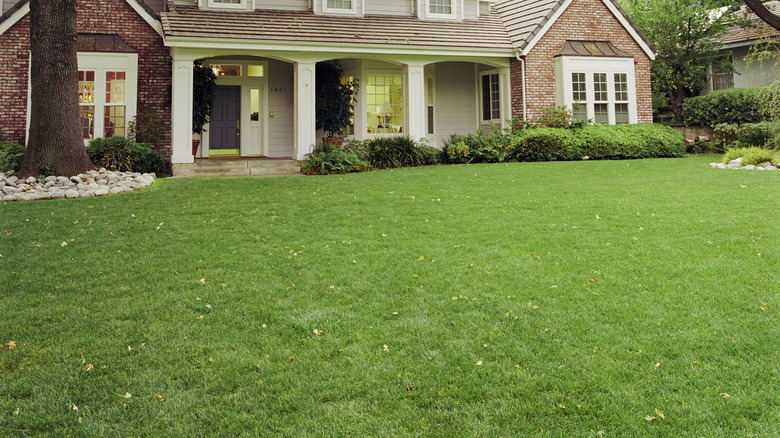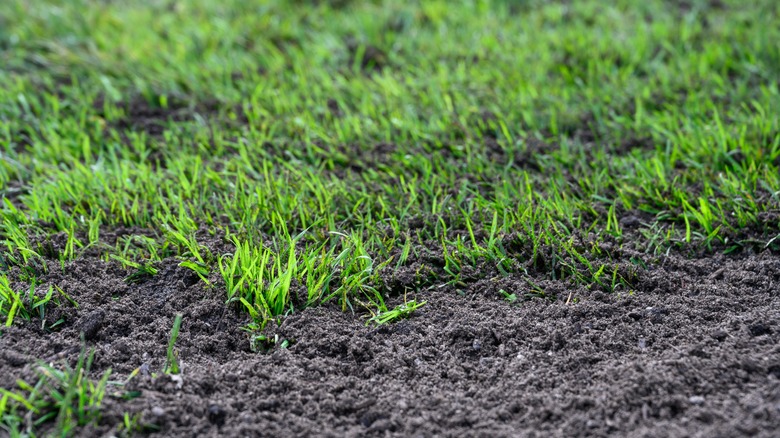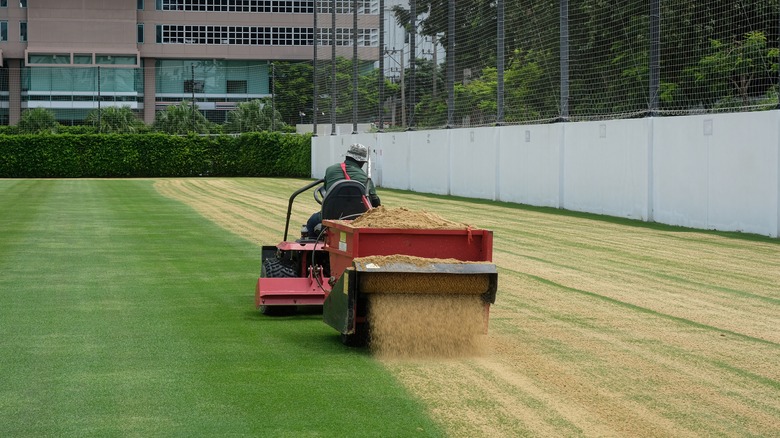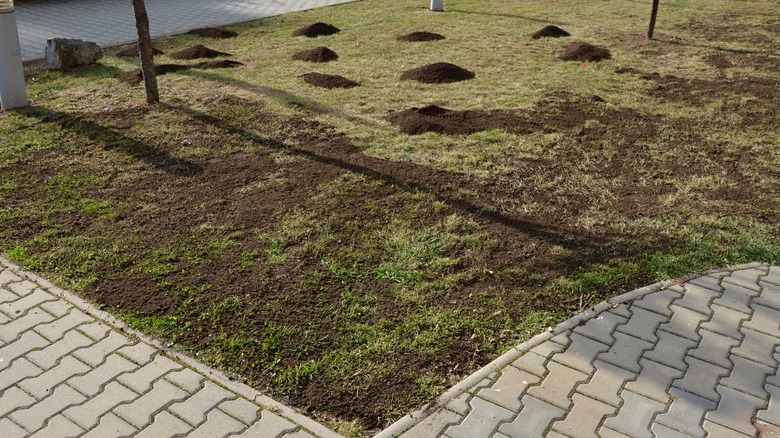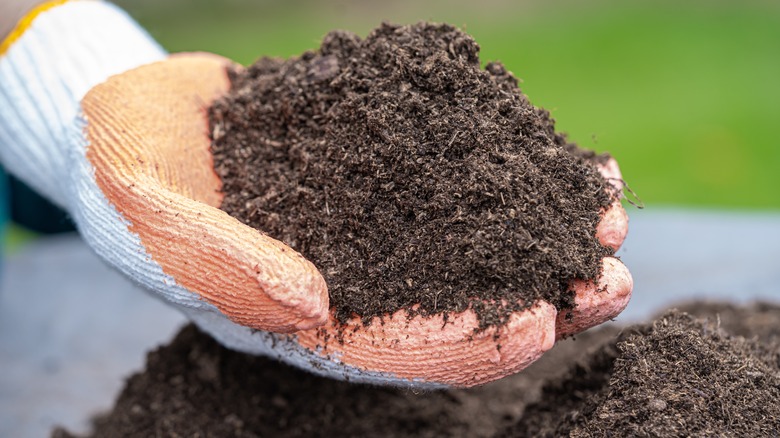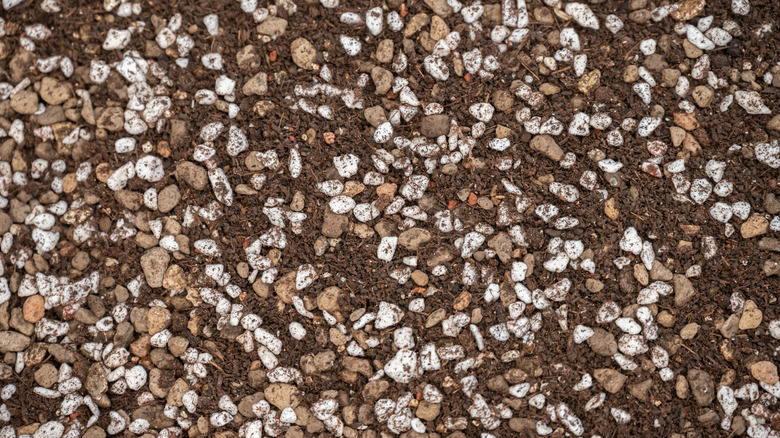5 Materials You Can Use To Top-Dress Your Lawn (& Which Is Best For Your Climate)
A pristine lawn is something every lawn lover strives for, but it can take some time and effort to get the healthy turf grass of your dreams. There are several ways to upkeep a lawn, and sometimes, you might have to bring it back to life after a period of neglect or rough conditions. One way to ensure your grass stays healthy is by top-dressing — adding a growing medium on top of your grass to fertilize or fill in low spots.
There are many ways to top-dress your lawn, but you need to be thoughtful about your methods. Choosing the wrong material can be detrimental to your grass and cause bigger problems than you started with, which is why some people advise against the practice in certain situations. Whether you choose sand, compost, peat moss, topsoil, or a mix, you need to research what your lawn already has and what it needs. You also need to consider how that growing medium will behave in your climate. Heavy clay topsoil won't be a good choice for consistently rainy weather, just as well-draining sand that holds little moisture won't do well in an area prone to drought.
Topsoil
You may think of a lawn as solid ground, but there are tons of micropores and macropores. These are little tunnels that allow water, roots, and air to move through the soil. A healthy lawn will have a balance of both — too many macropores result in a sinking lawn, while too many micropores can create compaction. The latter is often the biggest concern with topsoil, which is, by definition, the soil that's on the upper part of the ground. It's the stuff you probably call "plain old dirt." Topsoil comes in many forms, but you'll want a fertile and well-aerated mix that matches the composition of your current soil. If your lawn has sandy soil, you should choose a sandy topsoil.
Good topsoil has nutrients and organic matter in it, while the subpar stuff has very little nutritional quality. If you're top-dressing with topsoil to improve the health of your lawn, put in the effort to find a high-quality product that has organic matter in it and avoid anything that may contain rocks, weed seeds, or chemicals. Remember that heavy topsoils will have more micropores than macropores and may cause drainage issues when it rains or you water the lawn. Apply ¼ to ½ inch of topsoil — or any top-dressing you choose — at a time to prevent clogging up the ground underneath.
Sand
Sand is commonly used on golf courses to maintain solid ground. In a home lawn, however, using sand alone often isn't recommended due to its lack of nutrients, but there are still some reasons you should add sand to your lawn. Sand can be used to help aerate the soil and fill in low spots, but it won't improve the nutrient content of your lawn. More often than not, sand needs to be mixed with other components to bring any benefits to your lawn.
Be careful when using sand as a top-dressing. Though it's used for aeration, the University of Missouri Extension notes that using the incorrect proportion can make drainage problems worse. This will, of course, depend on the composition of the existing soil. Get your lawn soil tested to determine how much sand you should use for top-dressing, if at all. Sand doesn't hold any water, so using it in sandy soil in a dry climate will only exacerbate moisture control problems.
Compost
Compost can do a lawn some good thanks to its nutrient-rich content. Top-dressing your lawn with compost can help it recover from being dethatched or aerated and could potentially reduce diseases by adding microbes to the soil. If you're trying to rejuvenate a tired lawn, compost is most likely the way to go. But as with the other top-dressing materials, compost does have its downsides, too. It comes in many forms — some may be lightweight and airy, while others are heavy and stick together. The latter can hinder water and air and cause the grass to die out if it stays compacted for too long.
If you end up with heavy compost, spread it out with something large, like a section of chain link fence or wooden board with grooves. Make sure the compost layer is no thicker than ½ inch to ensure it doesn't weigh down the lawn. You may need to mix it with sand or aerate the lawn to mix it into the soil.
Peat moss
You can often find peat moss in potting mixes because it aerates the soil and promotes good drainage while also hanging onto water to keep plants moist. Using peat moss as a top-dressing will require some in-ground research — sample your lawn soil to see what it needs. If the soil is compacted and dry, peat moss is probably the right solution. However, if it holds a lot of moisture, peat moss may cause overwatering.
Peat moss may also be a good option if your soil is too alkaline or has a fungal infection. The Texas A&M Research Center tested it as a top-dressing on grass infected with take-all root rot (TARR). The grass improved over time, showing that the low pH of peat moss most likely killed off the fungi by creating an uninhabitable environment. To use peat moss safely and effectively on your lawn, be sure to do a pH test on your soil — if it's too alkaline (pH of over 7), the moss will reduce its pH. In this case, make sure your lawn can tolerate acidic soil.
A mixed blend
You don't have to stick to one material to top-dress your lawn. Lawns can be fickle and rarely have just one problem. With that in mind, using a mix of various materials can help your lawn be the best it can be. Your lawn can be dry and compacted, wet and too alkaline, or any other combination of issues. A balanced top-dressing blend will help you achieve the right weight, density, and nutrient content to give your lawn what it needs to thrive.
Remember that finding the right mix might take some work. For instance, don't add peat moss to a lawn with thatch because you may create too much organic matter and bog down the soil, causing drainage problems. And be sure to keep the mix aerated and thin so you can easily spread it over your lawn. If you're filling in low spots, well-aerated top-dressing is crucial to prevent it from choking out the grass.
